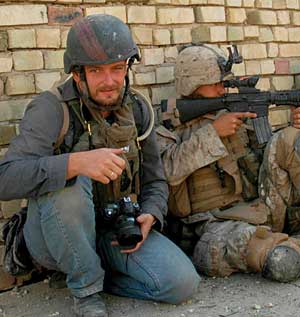
Photographer Ashley Gilbertson in Charlottesville
-

- Ashley Gilbertson (left), photo by Dexter Filkens.
The work of Ashley Gilbertson, an award-winning photojournalist, will be featured in the Summer issue of VQR (due July 1), in a portfolio titled “Framing the War: Photographs from Iraq.” Along with Gilbertson, the issue features work by photographers Carolyn Cole and Chris Hondros. Gilbertson, Cole, and Hondros are all past winners of the Robert Capa Gold Medal for war photography from the Overseas Press Club of America.
We’re also excited to announce that Gilbertson will also be in Charlottesville, VA on Saturday, June 9 at 1:30 p.m. at The Bridge to discuss his recent work covering the Iraq War. Ashley’s talk is free and open to all and is sponsored by The Bridge and VQR. It’s part of the inaugural Festival of the Photograph, a three-day celebration of photography.
For a preview of Ashley’s talk on 6/9 and his essay in the Summer issue, here’s an excerpt:
I didn’t want to go back.
When I began reporting from Iraq in 2002, I was still a wild and somewhat naïve twenty-four-year-old kid. Five years later, I was battle-weary. I had been there longer than the American military and had kept returning long after most members of the “coalition of the willing” had pulled out. Iraq had become my initiation, my rite of passage, but instead of granting me a new sense of myself and a new identity, Iraq had become my identity. Without Iraq, I was nothing. Just another photographer hanging around New York. In Iraq, I had a purpose, a mission; I felt important. I didn’t want to go back, but I needed to—and for the worst possible reason: I wasn’t ready for it to end. After twelve months away, I had a craving that only Iraq could satisfy.
My wife didn’t like the idea. Neither did my shrink. “If you go back to Iraq now,” he warned, “you’ll probably keep going back.” To be completely honest—and I wasn’t being honest with myself then—part of me knew they were right. Still, I could easily rationalize my desire to anyone who asked. I told them that I wanted to have one last look, that I needed to shoot the place differently, outside the constraints of daily coverage; I said I wanted to photograph Iraq emotionally, to react to my feelings on the spot instead of bottling them up as I’d done in the past; I said I wanted to be sure that my book of war photographs was indeed finished, that the story had irrevocably turned. The only people who bought my justifications were my editors at the New York Times. They thought another rotation was a great idea.
I felt pretty confident, and a little champagne-drunk, when I fell asleep in the plane on the runway a few weeks later. An ice storm had crept up on the city, and there was no way to know when my flight would clear for takeoff from Kennedy. When I awoke eight hours later, I was still in New York. My buzz was gone, and so was my confidence. Other passengers were demanding to know when we were going to leave, but I had bigger, equally unanswerable questions. We took off for Amman, and I spent the twelve hours sleepless, wondering what I was doing, what exactly the story was I thought I was chasing, and how much luck I had left—if it hadn’t already run out completely.
Ashley’s complete essay with eighteen of his photos are in the Summer issue of VQR, due on newsstands July 1.
